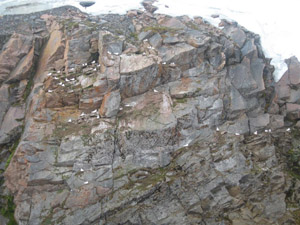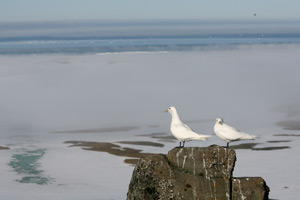Nordaustlandet's wildlifeBy Øystein Overrein
You can register your observations of marine mammals around Svalbard in the Norwegian Polar Institute’s database Marine Mammals Sightings. 

The ocean currents are cold to the east of Nordaustlandet. The eastern coast is unproductive. In the north and west warmer Atlantic water is supplied from the west, and provides for more life. This is why the northern coast is full of bird cliffs, nesting sites of the common seabird species, such as northern fulmar, glaucous gull, black-legged kittiwake, little auk, black guillemot and Brünnich’s guillemot. Most of the bird cliffs can be found along the coast between Murchisonfjorden and Kapp Bruun, in the Sjuøyane islands and around Wahlenbergfjorden. The largest kittiwake-mountain is located on Sjuøyane by Rijpfjorden and in Duvefjorden. Alkefjellet in Hinlopen is one of the largest guillemots localities in Svalbard. Ivory gulls nest several places in the nature reserve. Barnacle geese have been found nesting by Trollneset and on several islands in Hinlopen. Pink-footed goose nests som places east of Hinlopen, while Brent geese nest sporadically several places north in Nordaustlandet. Common eiders also nest around the whole island, while the Arctic tern sticks to the north-western corner. Polar bears can be seen anywhere on Nordaustlandet, all year round. How many polar bears spend the summer there depends on the distribution and form of the sea ice and the bears’ access to food. It is not unusual for several polar bears to gather around whale carcasses that have drifted ashore. Within the reserve there are important denning areas for polar bears. Kong Karls Land is known to have a high density of polar bear dens in good ice winters. As for other marine mammals, there are ringed seals, bearded seals, walrus, minke whales and white whales. Some of the most important haul-out sites for walrus in Svalbard are in the north-west, north-east and south-west of Nordaustlandet, on Storøya and in the east of Kvitøya. In most of these sites there are only males, although in more recent years females with calves have began to settle here as well. They are much more vulnerable to disturbances than adult males. This is why visitors must exercise great caution, and keep at a distance to avoid disturbing groups that include females and calves. The reindeer population is small compared to central parts of Spitsbergen and on Edgeøya. Reindeer can be found scattered around the ice-free part of Nordaustlandet, but not on Storøya and Kvitøya. The population was estimated at 400-500 animals at the turn of the century, but numbers fluctuate. The Arctic fox is a common sight. There are many waters and waterways with Arctic char on Nordaustlandet; both of the stationary freshwater type and the anadromous variant. It is not permitted to fish for char. Updated May 2015 |
The Cruise Handbook is also available in book formHard cover with numerous pictures - 249 pages - NOK 249.00 Norwegian Polar Institute |
 Norsk
Norsk